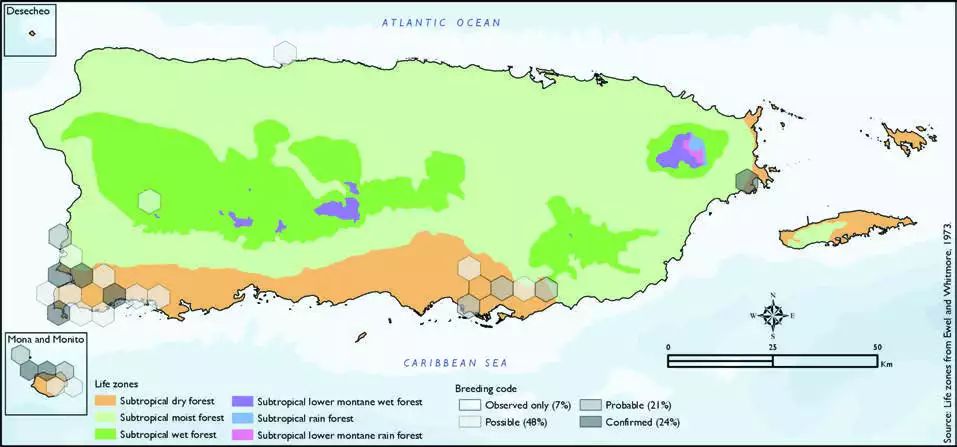Yellow-shouldered Blackbird
Description
The yellow-shouldered blackbird (Agelaius xanthomus), also known as in Puerto Rican Spanish as la mariquita de Puerto Rico or capitán, is a diurnal blackbird endemic to the archipelago of Puerto Rico and belongs to the genus Agelaius of the family Icteridae. It has black plumage with a prominent yellow shoulder on its wing. Adult males and females are of similar appearance. The species is predominantly insectivorous.
The yellow-shouldered blackbird, as its name implies, is a glossy black bird with a small yellow humeral patch around its "shoulders" outlined by a white margin. Immature individuals possess a duller coloration and a brown abdomen. Although plumage coloration is indistinguishable between the sexes, sexual dimorphism is present in this species with males being larger than females. Plumage abnormality is rare in this species. Adult individuals measure from 20–23 cm (7.9–9.1 in); on average, males weigh 41 g (1.4 oz) and females weigh 35 g (1.2 oz). Sexual categorization may also be made by measurement of the wings, with males' being 1.1 times larger and having a mean length of 102 cm (40 in), while females' wings have an average length of 93.3 cm (36.7 in).
Distribution & Habitat
The Yellow-shouldered Blackbird is an endemic and endangered
species in Puerto Rico that can
be found primarily in mangroves
and arid scrubland (Raffaele and
others 1998) (see map). The species
was once commonly found in the
coastal forests of the archipelago
of Puerto Rico (Wetmore 1916),
but during the early 20th century, Puerto Ricos coastal forests
were destroyed for sugar cane
plantations and later for urban
development (Post 1981, USFWS
2011). According to Oberle (2018),
the Yellow-shouldered Blackbird
was formerly found in lowlands
around Puerto Rico. At present, the
species is primarily limited to four
areas: Mona and Monito islands,
and three populations in eastern,
southern, and southwestern Puerto
Rico, where the largest population
is found (in the municipalities of
Cabo Rojo and Lajas) (USFWS 2011).
The species has been observed as
far inland as the mountain towns
of Lares and Ciales (USFWS 2011).
The atlas fieldwork yielded a total
of 60 records within 29 hexagons
or 6 percent of the 479 hexagons
(see map). Of the 29 hexagons
where this species was found, breeding met the atlas definition of
confirmed in 24 percent (7) of the
hexagons, probable in 21 percent
(6), and possible in 48 percent (14),
while the species was observed
in 7 percent (2) of the hexagons
but without evidence of breeding
(see map). Atlas results support the
current distribution described in the
literature for the Yellow-shouldered
Blackbird. Yellow-shouldered Blackbird distribution. The map shows the highest breeding code by hexagon and overlaying the ecological life
zones in Puerto Rico. Note: percentages may not total 100 due to rounding.

Breeding Habits
The Yellow-shouldered Blackbird
nests in a variety of sites, including
cliff crevices or cavities in trees
and in palms at the base of palm
fronds (Biaggi 1997, Oberle 2018,
Post 1981, Raffaele and others
1998). Previously published reports
indicate that breeding activity
occurs from February to November, 267Yellow-shouldered Blackbird/Mariquita but the beginning of the species breeding season coincides with the
onset of the rainy season, which
explains the fl uctuation in the start
and end of the breeding period
(USFWS 2011). Atlas results indicate
breeding activity occurs year-round,
except for the months of August
and September, when no breeding
data are available (see chart). Most
breeding evidence is clustered in the
subtropical dry forest life zone (81
percent of the hexagons), followed
by the subtropical moist forest life
zone (15 percent of the hexagons)
and one hexagon in the subtropical
wet forest life zone (4 percent of the
hexagons) (see table and map).
Conservation
The Yellow-shouldered Blackbird is
listed as Endangered by the IUCN
(BirdLife International 2017) and by local and Federal laws (PRDNER
2016; USFWS 1973, 2011). Nest
parasitism by the Shiny Cowbird
(Molothrus bonariensis) is the single
most important factor reducing
blackbird reproductive output on
Puerto Rico (reviewed in Cruz and
others [2005]), but other factors
including habitat loss, predation,
and low effective population size are
also affecting the species population
viability (Liu 2016). Trapping of
cowbirds and providing blackbirds
with nest boxes, which the cowbirds
do not enter, has resulted in
fewer parasitized blackbird nests,
and parasitism declined from 95
percent (from 19731983) to <3
percent (from 20002003) in the
southwestern portion of the island
(Cruz and others 2005). The Mona
population of blackbirds is less
threatened by cowbird parasitism
as the female cowbirds will not enter the cavities in cliffs used
for nesting by the blackbirds on
Mona. The USFWS considers the Yellow- shouldered Blackbird population to be improving because
the population has a high recovery
potential with a population size
increasing since 1995 and because
some of the major threats to the
species have been greatly reduced
(USFWS 2011). In Puerto Rico, the
Yellow-shouldered Blackbird has
a protected habitat in land of 16
percent (103 km2) of the total area covered by the hexagons where
this species is known to breed (648
km2). In addition, the PRDNER proposed to designate natural
critical habitat in locations within
the municipalities of Cabo Rojo,
Ceiba, Guánica, Guayama, Lajas,
Mayagüez (including Mona and
Monito), Salinas, and Santa Isabel
(PRDNER 2009).
Related Species
Family:
blackbird